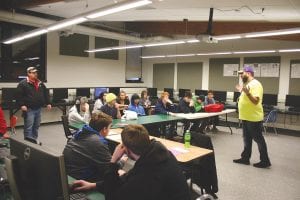Cook County High School robotics coach Rob Hackett talks to his team about the upcoming season. The kids will have six weeks to build and program a robot from the ground up and get it ready to compete in a regional competition that will be held at the Duluth Entertainment Convention Center in March. This is the largest regional competition in the U.S.A. and the top teams get to move on and compete at nationals. Two years ago Ice Storm narrowly missed out on qualifying for nationals. How will they do this year? Only time, hard work, some luck and the ability to work together will tell.

CCHS robotics coaches Rob Hackett and Tom Nelson held the Ice Storm’s first meeting of the year on Wednesday, December 6 in the high school shop. Twenty-three kids grades 9-12 are participating in the robotics competition, said Mr. Nelson, who has volunteered as an assistant since the program began in 2009.
“We are senior heavy this year. I would like to see some younger kids come out so we can continue the program well into the future,” said Nelson.
Addressing the kids, Rob Hackett asked them to split up by skill level into six units. Each unit, or team, would be in charge of one of the following: Drive team (certain kids will drive the robot during competitions); Build team (some kids will build the mechanical ’bot); Program team (kids with computer skills will program the robot to do needed tasks); Marketing team (the main competition cost $15,000, and the team has to raise funds to pay for the $4,000 robot, room, and board, etc); Safety team (certain kids will make sure safe practices are being followed during practice and at the competition(s); Graphic Design team (they will handle the art work for the shirts, robot, posters, etc.).
Like a sports team, robotics teams have to gel before the competition.
And like a sports team, strategy will play a big part of game day. That’s why the Ice Storm will have a scout team.
What will a scout team do, you might ask?
At competitions, robotics teams are paired in threes, called alliances. Three teams compete in three-minute games against three other teams. The individual groups get paired at random in alliances as they proceed through the two-day event. If your ’bot ends up on the winning side of most competitions, your team can advance to the finals like Cook County did two years ago. At that point, the final few teams pick the teams they think can best help them advance to the championship match. That’s where a scout team comes in.
Two years ago Cook County picked teams whose robots broke down or weren’t strong in the areas where the CCHS robot was weak. The CCHS team lost its last two matches, and a trip to nationals was gone. This year kids will watch all of the teams and assess the skills of the robots and drivers to see which squad(s) could best help CCHS.
The kick-off for the FIRST robotics season is January 6 where around the country (and world) certain locations are used to introduce “The Big Reveal” which gives instructions to teams on what is needed in the tasks the robots are supposed to do in competition.
FIRST stands for Inspiration and Recognition of Science and Technology. Dean Kamen, the founder, describes his vision for the organization, “To transform our culture by creating the world where science and technology are celebrated and where young people dream of becoming scientists and technology leaders.”
Each attending team received a kit of parts made up of motors, batteries, control system components, construction materials, and a mix of additional automation components—with limited instructions. Working with adult mentors, each team has six weeks to design, build, program and test their robots to meet the season’s engineering challenge.
Once the robots are made, teams will participate in one or more of the 145 Regional and District events that measure the effectiveness of each robot, which is controlled in collaboration with teammates.
Students who participate in robotics learn practical skills like welding, cutting metal, wiring, machining parts, mechanical engineering, and coding. They also learn to work together as a team, gain self-confidence, leadership and communication skills.
Nelson said kids who participate in robotics learn about teamwork as well as practical skills.
The significant competition for Ice Storm is March 7 to March 10 at the Duluth Entertainment Convention Center (DECC).
Last year teams came from Minnesota, Wisconsin, North Dakota and one squad came all of the way from Sydney, New South Wales, Australia.
“There will be 120 teams in Duluth for the Northern Lights regional competition, making it the biggest robotics event in the country,” said Nelson.
Until it is time to start building the robot, Ice Storm will be holding fundraisers or contacting businesses for some financial help. In the past Arrowhead Electric has been the team’s biggest sponsor with Kids Plus and many other organizations chipping in to help bring the cost down for the kids.


Loading Comments